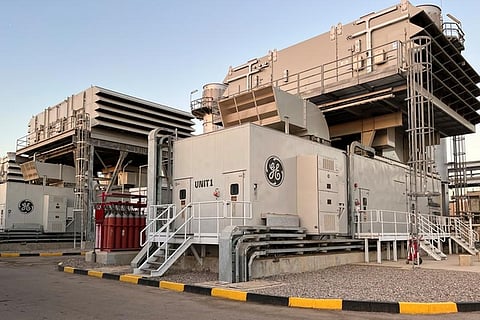Sharm El Sheikh: Hydrogen–natural Gas Blended Fuel Turbine Operational
H.E. Dr Mohamed Shaker El-Markabi, Minister of Electricity and Renewable Energy of Egypt, announced the successful operation of a GE LM6000 aeroderivative gas turbine on hydrogen–natural gas blended fuel at the Sharm El Sheikh Power Plant.
The demonstrations of the unit running on the mixed fuel ran at different times during the United Nations Framework Convention on Climate Change’s (UNFCCC’s) 27th session of the Conference of the Parties (COP27), termed the ‘Implementation COP’.
A proof of concept, the project illustrates that it is, in fact, possible to generate lower carbon, reliable, on demand power by burning hydrogen-blended fuels in gas turbines.
The project was executed less than five months after a strategic cooperation agreement (SCA) was signed among Egyptian Electricity Holding Company (EEHC), GE, Hassan Allam Construction, and PGESCO.
It is the first time that GE’s LM6000 gas turbine was run on hydrogen-blended fuel on the African continent.
Africa Primed to Become Global Green Hydrogen Leader: Masdar Report
H.E. Dr. Mohamed Shaker El-Markabi said: “We must all take urgent actions to address the climate challenge. We need to act today – not years from now – to invest in solutions that can provide lower carbon energy, and Egypt is well-positioned to play a leading role in this energy transition.
"Today, as I announce the successful operation of a GE LM6000 aeroderivative gas turbine on hydrogen-blended fuel right here in the city of Sharm El Sheikh during Energy Day at COP27, the world can see what is possible when you bring big dreams, strong resolve, and committed partners together.
"The combination of EEHC’s commitment and facilitation, GE’s global, industry-leading expertise in hydrogen-fueled power projects, and Hassan Allam and PGESCO’s strong on-the-ground construction and engineering capabilities, led to the extraordinary achievement of the safe, on time, and successful completion of this demonstration pilot.”
EEHC owns and operates the Sharm El Sheikh Power Plant. GE led the conception, planning, and execution of the project, as well as the building of the hydrogen-natural gas blending system.
Hassan Allam supplied the manpower and equipment needed for installation, related civil works, hydrogen needed for testing, and the piping and cabling system that transported hydrogen to the mixing skid and the turbine. PGESCO helped design the project and provided engineering expertise.
“We commend the strong actions being taken by the Government of Egypt to bring the world together at COP27 to remain focused on creating a lower carbon energy future,” said Joseph Anis, President and CEO of GE Gas Power in Europe, Middle East, and Africa.
“GE is committed to collaborating closely with the Government of Egypt, as well as other customers and partners to address the climate challenge.
"We were honored to design the overall hydrogen-natural gas demonstration project at Sharm El Sheikh; identify various parties to lead engineering, procurement, construction, hydrogen supply, safety initiatives, and other works.
"Provide the critical blending skids needed to mix the hydrogen and natural gas; and then drive coordination efforts among all parties involved to bring the project to successful completion. This is an excellent example of what it means to be together for implementation.”
GE has over 30 years of experience with more than 100 gas turbines that have operated on fuels that contain hydrogen globally, accumulating more than 8 million operating hours.
Earlier in 2021, GE announced a collaboration in North America to run an LM6000 unit on a blend of hydrogen and natural gas.
Learnings from the project were applied by GE at Sharm El Sheikh and shared with other project partners, leading not just to the successful completion of the project, but also to a significant transfer of knowledge and local capacity building in the utilization of hydrogen as a fuel for power generation.
“The progress made on such a mega project in less than five months is a testimony to what national Egyptian conglomerates can achieve with our partners,” said Ahmed Ramadan, CEO of PGESCO.
“Despite the project’s narrow timeframe and challenging nature, PGESCO, with its extended local and regional expertise in managing power projects, built rapid capabilities to overcome various challenges, including the management of hydrogen for electricity generation at a live power plant.
"This project is a milestone in Africa and the region, illuminating how we can use hydrogen-blended fuels for future energy production.”
The project illustrates that gas turbines offer great potential to operate at lower carbon intensity and can complement the growth of variable renewables by providing on demand electricity to firm the grid.
The safe execution of the demonstration also tells us that while hydrogen does present certain unique challenges with transportation, storage, and use at site for power generation, those obstacles can be overcome with the right arrangements, trainings, and precautions.
Finally, the successful adaptation of an existing installed unit to run on hydrogen-blended fuel also clearly highlights that today’s gas power generation assets can be a destination technology, not just a bridging technology, as the world scales up the production of hydrogen.
This is important for countries that have made considerable investments of billions of dollars in these assets. Looking ahead, learnings from this project can be studied by organizations around the world, to potentially improve the execution of future hydrogen-fueled power all over the world.
Read More: Aramco and Pertamina Explore Hydrogen and Ammonia Value Chain


